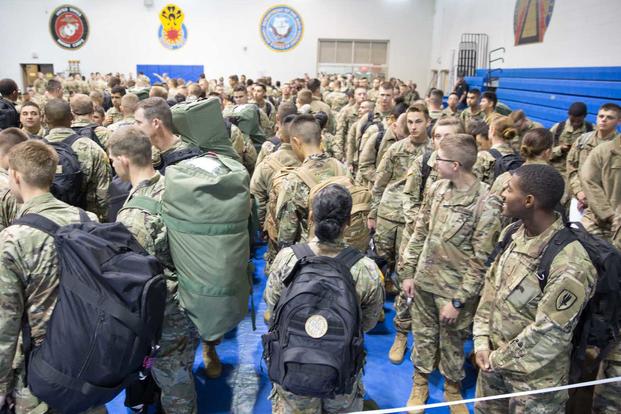The Army recently rolled out a major update to leave regulations that includes changes ranging from more user-friendly leave forms to clearer descriptions of the service's parental leave policy.
The June 3 revision of Army Regulation 600-8-10, which covers leaves and passes, is part of the largest update to Army military leave policy in more than a decade, Larry Lock, chief of Compensation and Entitlements for the Army's G-1 office, said in an Army news release.
Read Next: The Marines Are Pumping Millions into a High-Tech Wargaming Center. Here's Why
"We're an all-volunteer force since 1973, and to sustain our force we want to take care of our people," Lock said in the release. "One way to do that is to streamline the process for requesting leave and enhance morale by encouraging soldiers to take time off."
Based on input from soldiers, the service improved the Department of Army Form 31, or Request and Authority for Leave, which has not been updated since 1993, Lock said.
"To be a more usable form ... the Army updated the DA Form 31 to make sure commanders and soldiers clearly understand what type of leave was chargeable and what type was non-chargeable," he said. "Soldiers, Army leaders and commanders need to keep track of leave, for personnel reasons and for audit purposes."
Soldier feedback resulted in larger fields for leave address, remarks and organizational address. While it is not required by regulation, soldiers can now enter three or more addresses where they expect to stay while on leave, the release added.
The revised regulation also updates DA Form 4179, or Leave Log, to help personnel officials track the absences requested, approved or disapproved for soldiers in their organizations, according to the release.
Both the new DA Form 31 and the new DA Form 4179 are available on the Army Publishing Division website.
The revised policy includes more explanation of the military parental leave policy (MPLP) the service launched last year.
"The leave policy associated with childbirth can be somewhat confusing, and the revised regulation helps soldiers navigate through the different leaves," Lock said in the release.
The MPLP applies to active-service soldiers, Reserve component soldiers performing active Guard and Reserve duty or full-time National Guard duty for a period in excess of 12 months, and Reserve Component soldiers performing duty under a call or order to active service in excess of 12 months, according to the policy regulation.
There are three different types of leave associated with the birth of a child: maternity convalescent leave, primary caregiver leave and secondary caregiver leave.
New mothers are authorized 42 days of non-chargeable maternity convalescent leave upon release from the hospital or birthing center.
If two soldiers are married, only one member of each couple may be designated the primary caregiver and one designated the secondary caregiver, according to the regulation. The primary caregiver is authorized 42 days of non-chargeable primary caregiver leave that must be taken within 12 months of qualifying birth events, but it does not all have to be taken in a continuous block, according to the release.
The secondary caregiver is authorized 21 days of non-chargeable secondary caregiver leave, which also needs to be used within 12 months of the qualifying birth and is not required to be taken in a continuous block.
Previously, a parental leave of only 10 non-chargeable days was available for non-birth parents and had to be used within 45 days after the birth.
While much of the MPLP policy has not changed, "the Army is striving to help troops better understand their benefits, especially the young soldiers who make up the majority of new Army parents," Lock said.
Soldiers earn 30 days of paid leave per year, beginning with their first year on the job.
"Every month, soldiers have the personal responsibility to verify the accuracy of their leave and earnings statements, which shows their balance, the amount of leave they used during the current fiscal year, and the number of leave days they will lose if they don't take it before the end of the fiscal year," Lock said.
Soldiers may request a non-chargeable absence to volunteer in a semi-official capacity at major events for organizations such as the Boy Scouts and Girls Scouts, the release states. This was previously authorized by AR 600-8-10, but it now falls under an umbrella category of "Administrative Absences," Army officials said.
While scouting events are not named in the regulation, volunteering for such an activity "would be considered a non-chargeable absence from duty, which may be granted ... to perform a semi-official activity benefiting the service and the soldier," according to the regulation.
The Remarks section, beginning on Oct. 31, will state the maximum leave soldiers can carry over at the end of the fiscal year, and when the ability to carry more than 60 days will expire, the release states.
One of the biggest leave problems, Lock said, is getting soldiers to take their leave.
"Soldiers are very dedicated to their jobs, to the point that they are reluctant to take leave," he said. "It is good to know that they are really dedicated, but they also need to make their own well-being and their families a priority.
"It is a commander's role to grant time off, when possible, but it is still the responsibility of every soldier to manage their own leave."
-- Matthew Cox can be released at matthew.cox@military.com.
Related: Army Doubles Parental Leave for Secondary Caregivers













